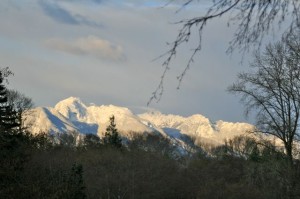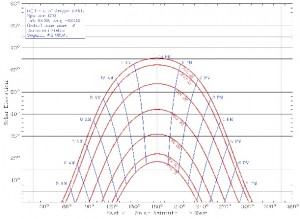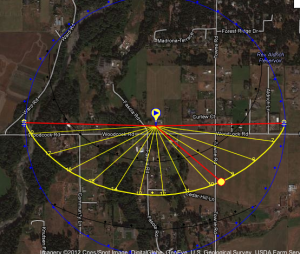Do you know where your sun is?

We have reached that turning point, all things being equal, which, of course, they are not – when day equals night and darkness turns to light.
When the sun hits the sky and the temps climb toward 55, we Vitamin D-starved souls in the Pacific Northwest throw off our clothes and dance in circles and raise our hands to the sun in praise. “Let the wild rumpus start!”
Even though true outdoor heat is still just a warm dream for those of us who can’t escape to a tropical sandy beach somewhere, it is now officially Spring, folks, and that is definitely worth capitalizing and celebrating.
The Equinox Paradox
We all know it eventually happens every year, and yet how it comes about exactly is still a convoluted mystery to many of us. The Vernal Equinox marks that day when, as the world turns, we will see more and more daylight. Most of us mark the date as March 21. The truth is, however, we missed the real balancing point already. For those on the East Coast, it was yesterday. For us, it was even earlier, on the night of March 19. In fact, those who know these things say that spring technically arrived this year the earliest since 1896.
How can this be? How could this important event quietly happen when the great majority of us were sleeping? How can we all think the equinox is on March 21 when in reality, it only occurs on that date maybe 30% of the time?
The truth is, the equinox is simply a moment in time when the sun is neither more above, nor more below – but right at – the “celestial equator” – a term I find amusing because it sounds like there must be a middle of the universe out there, but is really just the idea of the Earth’s equator projected outward. We Earthlings traditionally like to think of ourselves as the center of the universe, after all.
You can blame the Gregorians for the differences about when this happens (actually, it was the Pope, but we’re not going to go there). As we were leaping over the last day of February, we were playing catch-up to an imperfect system that says it takes 365 days to dance around the sun, when it actually takes about 365.25, more or less.
Of course, you also have to factor in that the Earth is not a perfect sphere (like many of us, a little fatter around the middle) and it tilts (as many of us do after 5), so if you’re looking for that perfect 90-degree angle to the sun, you might have to wait.
If that’s not enough to make the Earth wobble on its axis, don’t forget the pull of the moon and other planets, also in perpetual motion. I think I feel them tugging at me right now, in fact.
Moreover, if you are looking for that moment when daylight and night are exactly the same, consider that sunrise is defined by when the first edge of the great yellow orb rises on the horizon (I’m assuming at sea level, which we don’t see here, because there are a few mountain ranges in the way), and it sets when the last bit of sun (not the center) sets in the west (coast is clear! we get fantastic sunsets here!).
But also remember that refraction throws everything off even more. Our atmosphere bends the light. Which means, when we think we are watching the sun rise or set, we are actually watching an illusion. Do not confuse this, however, with the Green Flash, which is a real phenomenon, not just something exalted by dancing substance-infused individuals, names of whom we won’t release here.
Throw in the kink with Daylight Savings Time, something I’ve never quite understood the logic in.

Ok. We get it. The Equinox came and went while we were sleeping. Most of us didn’t know and didn’t care what time it was. What matters is, it is officially Spring. People east of the Mississippi have been thinking this for months – and if it’s warm there now, you gotta wonder how they’re going to suffer through August. For us in the Northwest, though, we’re in another La Nina chokehold. According to Cliff Mass’ weather blog (one of my favorites, nerdy person that I am), in the last month, only 4 days have been at or above normal. Everything else is pulling down the bell curve. The mountains and every skier on them have been inundated with snow, and avalanches have been a serious risk that has cost lives.
For us in the lowlands, however, it’s just another dreary day until you get a glimpse of those first snowdrops of the flowering kind. Daffodil bulbs are bulging, also a good sign. Pussy willows – who does not adore them? It’s a feel-good time of year, despite the wind and rain.
On the practical side, the equinox is a great opportunity to take note of where the sun is in relationship to our gardens.
For example, in the middle of winter, it was interesting to look at the melting snow and see which areas melted first and which last. I would have thought the morning sun would have melted the eastern side by midday. The reality, however, was that the sun was so low in the sky, that it did not get above the row of tall firs bordering the neighbor’s property across the road to reach that side of our house. By afternoon, when it was higher in the sky, it was on the other side of the house, which then cast a shadow to the east. I might not have otherwise thought of this little microclimate staying so cold and wet. In the afternoon, despite all the tall trees on our northern side of our property, the snow melted quickly and everything dried out. Thump on head! It faces south! Whereas the southern side stayed cold and dark and was the last to thaw, because we built a fence alongside the edge of the road to block the traffic noise, so now the “south” side was actually on the north side of the fence, which kept everything in the shadows.
Everything changes a little later in the year. Now, as I write this at 9:30 a.m., which, technically speaking would be 8:30 a.m. if we could stay in one timeframe (we’re not “saving” anything with daylight time! What was Benjamin Franklin thinking? I believe it’s a conspiracy that coincides with the Ides of March!), the sun is already high above the neighbor’s row of trees and shining on a little clump of daffodils, which are just loving it. Two hours from now, though, it will be directly behind a big fir tree, and the flowers will be in the shadows again, at least for a few hours.
The fact is, the light and its availability is always changing. Here at approximately 48-degrees latitude, the sun doesn’t really rise in the east and set in the west all year long. In the summer, it rises more in the northeast and arcs high across the sky to span nearly 270 degrees to set in the northwest. In the winter, that arc is lower and smaller.
So how do we apply this information?
We can become more aware of where the sun is at different times of day and year. The equinoxes and solstices are good points to mark those differences and maybe make a map of different garden areas, how the light changes, and how microclimates are created in the process. We can plot the arc of the sun at various times of the year – lower in winter and higher in summer and how it changes from one month to the next – along with other structures and plants that might alter the availability of that light – and then better determine the best place to plant something so it can reach for the light it needs.
For example, an overstory plant, such as a fruit tree, might need 6 to 8 hours of sunlight (and warmth!) for the blossoms to open and for the fruit to ripen. Where can we plant it where it can get this minimum daily requirement (MDR) when it needs it most? Or would we be better off with selecting something that has a higher tolerance for variation?
Or – if the site for a particular sun- and heat-loving plant isn’t ideal, is there something we can do to create a little microclimate, such as planting plants in a south-facing U-shape around it to trap the heat? Too much heat is rarely a problem here, but you might also need something quite the opposite to provide more shade or to protect from the drying effects of a late afternoon summer sun that is still relatively intense at 6 p.m. (wishful thinking, I know).
Cool Tools for Tracking the Sun


If you can’t wait a year to synchronize your back yard with your sundials, and if you really like precision, you might want to take advantage of several of the sun charts now available on the web. My favorite that I’ve found so far is the Sun Path Chart Program, produced by the University of Oregon. Just plug in your zip code and voila.
Another good one is at Sun Earth Tools, which overlays the movement of the sun on a particular day with your site, as plotted on Google Maps.
Oh, and in case you didn’t know, according to The Old Farmer’s Almanac, it’s the night of the new moon, but actually, the new moon isn’t until 7:39 tomorrow morning. Go figure (or not) – just in case you’re feeling the effects of a force that is strong enough to move large volumes of water.
Some of this is a little mind-boggling. All I know is that it’s sunny outside right now, so I’m going to go soak up a little of my MDR of Vitamin D before I experience any more cognitive impairment caused by a lack thereof. Or something like that. Whatever it was I was talking about.
List of links:
Cliff Mass’ Weather Blog : the very best site about Pacific Northwest weather
Space.com: More info on space and how the world turns
SunEarth Tools: great for solar designers & gardeners – Where is the sun and how do the rays fall on your favorite place on the planet?
Blythe, Thanks for the great posts and all the new toys to play with.
Hi Tom! Thanks for tuning in! I am trying to figure out a way to work these sun-plotting charts into a magic decoder ring – maybe with a compass in the center – so you could face a direction and know where your sun is at any time of year – I’m just not sure if I’d have to make it 3-D or what. I kind of get befuddled in the details, but if people see me wandering in circles in my yard, it’s only because I’m getting spring loaded. Ha! Hope you are dodging all the thunderstorms hitting your way!